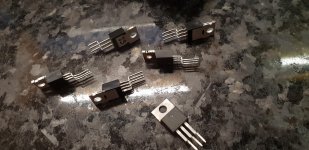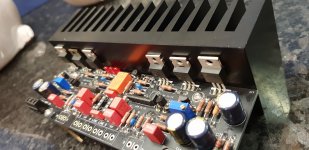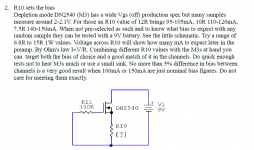Actually will take me a day or two longer as I need to get some de-solder braid because I don't want to damage the PCB and want the MOSFETs for testing.
Anyway many thanks for your fast and really helpful support so far. I will report back.
Cheers
Anyway many thanks for your fast and really helpful support so far. I will report back.
Cheers
Can a quick dc offset test be done without a heatsink? How long might be safe...or is it not worth the risk?!
Not worth the risk, M3 will be especially exposed to risk, which is the selected for IDSS one and not readily available in city shops
This is probably bit off topic, but do you have any suggestions for reasonably priced audio grade rotary input selector switch and stepped attenuator for volume control? Input RCA terminals will be at the back, but the input selector and volume control at the front. Planning to use extension shaft.
I am trying to make things as simple as possible for now, so no additional boards with relays etc.
I am trying to make things as simple as possible for now, so no additional boards with relays etc.
Well, a selector switch like LORLIN CK1040 or CK1035 and a 20K cheapo switcher pot will do the basic job
https://ie.farnell.com/lorlin/ck104...40&ddkey=https:en-IE/Element14_Ireland/search
DACT Type 21 Stepped Attenuator / Volume Control (Hi Fi Grade) * D shape Shaft * | eBay
https://ie.farnell.com/lorlin/ck104...40&ddkey=https:en-IE/Element14_Ireland/search
DACT Type 21 Stepped Attenuator / Volume Control (Hi Fi Grade) * D shape Shaft * | eBay
Just what I needed. Thank you Salas!
So this is probably an obvious thing to most here 🙂 I'll need to match DN2540 mosfet, what is the procedure/schematics to measure Vgs? Ordering from mouser, how many do you think I'll need to get matched pair? According to Hikari in post 839 it came very well matched, so planning to get only 5.
So this is probably an obvious thing to most here 🙂 I'll need to match DN2540 mosfet, what is the procedure/schematics to measure Vgs? Ordering from mouser, how many do you think I'll need to get matched pair? According to Hikari in post 839 it came very well matched, so planning to get only 5.
One question... Which toroid rating should be used if 1 toroid for each channel? 25VA per channel OK?
Hi Salas
I am really pleased with my DCG3 and recently added an arduino rig to control the relays and the volume pots..... but I would like to even get better bass..... Would a change to BC327 help in this region ?
What are the real benefits of this mod ?
I am really pleased with my DCG3 and recently added an arduino rig to control the relays and the volume pots..... but I would like to even get better bass..... Would a change to BC327 help in this region ?
What are the real benefits of this mod ?
Yes in my view. That type has much less intrinsic noise. Especially 1/F noise which is related to bass.
Heat sink came today so hopefully will be able to solder the Mosfets on and test.
Spent a while tonight cranking the fets so they will align flush with the heatsink
Mosfets not soldered here so they aren't straight yet....then I have to drill and tap the thing nicely!
Spent a while tonight cranking the fets so they will align flush with the heatsink
Mosfets not soldered here so they aren't straight yet....then I have to drill and tap the thing nicely!
Attachments
Yes in my view. That type has much less intrinsic noise. Especially 1/F noise which is related to bass.
Do they need to be selected for idss?
They are Bipolar Junction Transistors PNP (Q1 Q2) they should be selected for fairly close HFE
So this is probably an obvious thing to most here 🙂 I'll need to match DN2540 mosfet, what is the procedure/schematics to measure Vgs?
Nevermind, I should probably read the *** manual before asking 😀
Attachments
I state that I have not read all the 350 pages, but only the first 50 pages.
from the diagram on the first page I see that we have used a chip for the servo circuit for the DC.
To control DC is not able to do otherwise?
always avoiding the use of capacitors in output, okay !
the question because I have always noticed that the presence of a servo circuit affects much on the low range, even if placed in parallel the signal
the absolute selection of the input j fet couple and place them in close contact with each other to even out the temperature variationdoes own allow to control the offset too?
and not even placing a multiturn trimmer between the emitters of the 2 j fets in input?
I ask
from the diagram on the first page I see that we have used a chip for the servo circuit for the DC.
To control DC is not able to do otherwise?
always avoiding the use of capacitors in output, okay !
the question because I have always noticed that the presence of a servo circuit affects much on the low range, even if placed in parallel the signal
the absolute selection of the input j fet couple and place them in close contact with each other to even out the temperature variationdoes own allow to control the offset too?
and not even placing a multiturn trimmer between the emitters of the 2 j fets in input?
I ask
Last edited:
dominico80
I have tried to play without the servo opamp,,you will be surprised how little different in sound it give
I have tried to play without the servo opamp,,you will be surprised how little different in sound it give
will be that I can not stand the servant because I have never had positive feedback.
But, without servant, the offset remains stable?
But, without servant, the offset remains stable?
- Home
- Source & Line
- Analog Line Level
- Salas DCG3 preamp (line & headphone)


